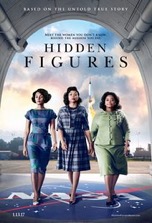Hidden Figures (PG)
06/02/17 00:53 Filed in: 2017

Starring: Taraji P. Henson
January 2017
What follows is the full-length review based on comments that were originally tweeted in Real-time from the back row of a movie theater @BackRoweReviews. Though efforts were made to tease rather than ruin this movie’s memorable lines and moments, some spoilers may exist in the following evaluation. For concerns over objectionable content, please first refer to one of the many parental movie guide websites. Ratings are based on a four star system. Happy reading!
Hidden Figures is an inspirational biopic that transports its audience back to a less progressive, yet more purposeful, period in American history. The story centers on three African American women who make substantial contributions to NASA’s rocket program during its most crucial decade, the Space Race 60s. Taraji P. Henson plays Katherine G. Johnson, a human “computer” with mad math skills. Octavia Spencer depicts Dorothy Vaughan, a mechanical genius who becomes an expert at operating the newfangled mainframe computers manufactured by some company named IBM. Janelle Monae portrays Mary Jackson, an ambitious young mother of two who wants to become an engineer. Each of the women is faced with significant obstacles along the way which threaten to sabotage their dreams. Johnson, who is treated with barely concealed hostility by many of her white coworkers, must run fifteen minutes in heels just to get to the closest “colored” bathroom and is eventually replaced by a real computer. Vaughan does the work of a supervisor but doesn’t receive the recognition or compensation for it. In order to be considered for an engineering position at NASA, Jackson must augment her Bachelor’s degree with extension courses which, as fate would have it, are only offered at night at an all-white high school. Although most of the story’s depictions are skin-deep, the acting elevates the cursory character development and the Caucasian co-stars certainly assist in that regard. Jim Parsons, in a very un-Sheldon like role (The Big Bang Theory), plays Paul Stafford, an arrogant, prejudiced physicist who seeks to undermine and discredit Johnson at every opportunity. In a similar role, Kirsten Dunst plays Vivian Mitchell, a persnickety boss who keeps Vaughan under her thumb and constantly quashes her ambitions for advancement. The closest thing we have to a decent white person in the film is Kevin Costner’s Al Harrison. What makes Costner’s performance here stand out from his typical role is that he isn’t portraying a hero or a villain…Harrison is a beleaguered supervisor tasked with putting a man in space and is simply trying to do that job to the best of his ability. One of the most refreshing aspects of Harrison’s character (a fictitious composite of three different directors at NASA Langley Research Center during Johnson’s tenure at the facility, according to historyvshollywood.com) is that he utilizes the best person for the job, regardless of race or gender—an admirable quality when considering the period when this movie was set. Although Costner has always looked at home in films (like JFK) set in the 60s, his appearance in Figures, which comes complete with horn-rimmed glasses, white dress shirt with thin tie and short cropped coif, is so authentic to the period that the line between actor and character becomes exceedingly blurred at times. The storyline is bifurcated between Civil Rights issues and a fly-on-the-wall perspective of the riveting operations inside NASA’s Space Task Group during Alan Shepard’s and John Glenn’s landmark missions. Unfortunately, the plot is fairly predictable, especially for those knowledgeable about these historical happenings, but credit goes to screenwriters Allison Schroeder and Theodore Melfi (also the film’s director) who have adapted Margot Lee Shetterly’s book into a compelling yarn that adroitly modulates between the home and work struggles of its three main characters. The addition of archival footage of various rocket launches and the newscasts that covered them also lends credibility and aids in maintaining viewer interest throughout the film. In the end, the movie’s objective was to raise awareness that there were many capable women, and what’s more African American women, working at NASA during the 60s. The film certainly succeeds on that front but also excels at being an enlightening endutainment. In addition to containing a first-rate double entendre in its title, Figures is a crowd-pleasing true story that underscores just a few of the myriad issues that faced our nation during one of its most turbulent decades. Figures affirms that it’s possible to reach the stars if we shoot for them.